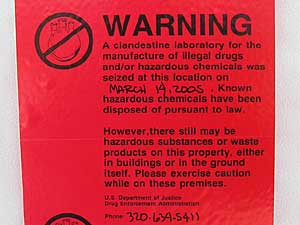|
Audio
Photos
More from MPR
|
April 15, 2005
 |
| This warning sign was put on the front door of a house in Glenwood, Minnesota after a meth lab was found inside. (MPR Photo/Tim Post) |
Glenwood, Minn. — There's a green ranch-style house in Glenwood that doesn't look at all out of place in the west central Minnesota town of about 5,000. It's a neatly kept home, just like all the others in the neighborhood. A child's toys are scattered around the front yard.
But locals provide a tip-off that something is not quite right. They slow down as they drive by, craning their necks to peek at the house. Their eyes are drawn to a red sign taped on the front door. It warns that this house has been sealed up, contaminated by a drug lab.
Last month firefighters and other first responders found a meth lab here, according Greg Windhurst, a local drug task force agent.
"It looks like they've been cooking for a while just from the wastes we found. It looks like they cooked a couple of ounces in a short amount of time," Windhurst said.
Standing outside the house, Windhurst says officers found discarded boxes from several different brands of cold medicine inside the home. There was also equipment set up in the garage to make meth. The residents of this house weren't home at the time, but were arrested later. They were charged with making meth, and with child neglect.
For Windhurst this a typical Minnesota meth house.
"A smaller type lab for personal use. They sell to their friends, not huge production," Windhurst said.
Most of the meth in Minnesota is not made in small labs like this one, it's brought into the state from super labs in other states or even countries. But these local labs still represent an incredible danger to cops and neighbors, because of the risk of explosions or toxic gasses.
And while all meth is bad for it's users, homemade meth is even worse. Meth brought in to Minnesota has been cut down in quality, by the time it hits the streets it's only 10 to 30 percent pure. Deborah Durkin at the Minnesota Department of Health, says homemade meth is 80 to 90 percent pure.
"Minnesota made meth is more potent and causes harm, disability, bad behavior much more rapidly. It hurts people more," Durkin said.
The Department of Health tracks meth lab busts yearly within a broad category of meth-related incidents. In 2003 there were 497 incidents reported by police in Minnesota. In 2004 that number fell to 317. Looking at those numbers, you'd think some headway is being made in the fight against the drug.
But numbers don't tell the whole story. Durkin says those statistics reveal a troubling trend, meth labs are getting harder to find.
"So we don't believe that meth production has decreased, but that meth lab detection is more difficult," Durkin said.
Police officials agree. Paul Stevens with the Bureau of Criminal Apprehension, says drug users who make their own meth are getting better at hiding their work.
"They're learning, they're adjusting, everytime one avenue gets squeezed off, they look for another," Stevens said.
In recent years there's been a lot of media attention focused on how drug users make meth. There are various recipes, but they all start with over-the-counter cold medicine. The pills are crushed and then mixed with different kinds of acids or solvents in a process called cooking. But now meth labs are portable and easier to hide. They can be small enough to fit in the trunk of a car, or even a back pack. The BCA's Paul Stevens says that's thanks to a new cooking process employed by meth makers.
"There's a method called the one pot method, where they just throw everything into one container. They can make one-fourth to one-half of an ounce of meth in a few hours just by mixing everything together," Stevens said.
Those simple meth labs are still toxic and dangerous operations, but they're easier to hide.
Cops are optimistic that a change in the law could help the fight against meth. A proposal in front of the Minnesota lawmakers would change how cold medicines containing pseudoephedrine are sold. The law labels them "Schedule Five" drugs, available only in limited quantities to people willing to show an ID at pharmacies. The idea is to restrict the basic ingredients for meth, to stop people from making the powerfully addictive and dangerous drug on their own.
It's a law that Oklahoma and Illinois officials enacted in recent years, one they credit for fewer homemade meth labs. Iowa put a similar law in place in March of 2005.





